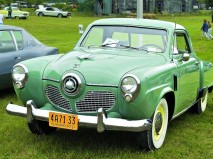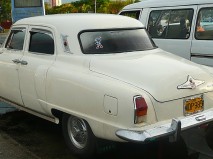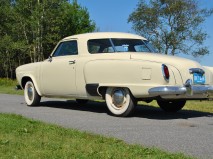1947 Studebaker Champion
In 1947, Studebaker completely redesigned the Champion and the Commander, making them the first new cars after World War II. The Champion made up 65.08% of the total sales for the automaker in 1947. The 169.9 cu in (2.8 L) I6 engine produced 80 hp (60 kW; 81 PS) in 1947. In 1950, output was increased to 85 hp (63 kW; 86 PS).
One of the new styling features on the cars was the wraparound, "green-house" rear window that was on two-door cars from 1947–1951, at first just an option, in 1950 it was given its own trim line, the Starlight coupe. The "spinner" grill was introduced in 1950, similar to that of a Ford Deluxe, but was dropped again for the 1952 model year.










